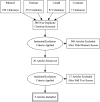Effects of the application of a checklist during trauma resuscitations on ATLS adherence, team performance, and patient-related outcomes: a systematic review
- PMID: 31392359
- PMCID: PMC7026213
- DOI: 10.1007/s00068-019-01181-7
Effects of the application of a checklist during trauma resuscitations on ATLS adherence, team performance, and patient-related outcomes: a systematic review
Abstract
Purpose: In this systematic literature review, the effects of the application of a checklist during in hospital resuscitation of trauma patients on adherence to the ATLS guidelines, trauma team performance, and patient-related outcomes were integrated.
Methods: A systematic review was performed following the Preferred Reporting Items for Systematic Reviews and Meta-analyses checklist. The search was performed in Pubmed, Embase, CINAHL, and Cochrane inception till January 2019. Randomized controlled- or controlled before-and-after study design were included. All other forms of observational study designs, reviews, case series or case reports, animal studies, and simulation studies were excluded. The Effective Public Health Practice Project Quality Assessment Tool was applied to assess the methodological quality of the included studies.
Results: Three of the 625 identified articles were included, which all used a before-and-after study design. Two studies showed that Advanced Trauma Life Support (ATLS)-related tasks are significantly more frequently performed when a checklist was applied during resuscitation. [14 of 30 tasks (p < 0.05), respectively, 18 of 19 tasks (p < 0.05)]. One study showed that time to task completion (- 9 s, 95% CI = - 13.8 to - 4.8 s) and workflow improved, which was analyzed as model fitness (0.90 vs 0.96; p < 0.001); conformance frequency (26.1% vs 77.6%; p < 0.001); and frequency of unique workflow traces (31.7% vs 19.1%; p = 0.005). One study showed that the incidence of pneumonia was higher in the group where a checklist was applied [adjusted odds ratio (aOR) 1.69, 95% Confidence Interval (CI 1.03-2.80)]. No difference was found for nine other assessed complications or missed injuries. Reduced mortality rates were found in the most severely injured patient group (Injury Severity score > 25, aOR 0.51, 95% CI 0.30-0.89).
Conclusions: The application of a checklist may improve ATLS adherence and workflow during trauma resuscitation. Current literature is insufficient to truly define the effect of the application of a checklist during trauma resuscitation on patient-related outcomes, although one study showed promising results as an improved chance of survival for the most severely injured patients was found.
Keywords: Adherence; Checklist; Process- and patient related outcome; Trauma resuscitation.
Conflict of interest statement
The author declares that they have no competing interests.
References
Publication types
MeSH terms
LinkOut - more resources
Full Text Sources


